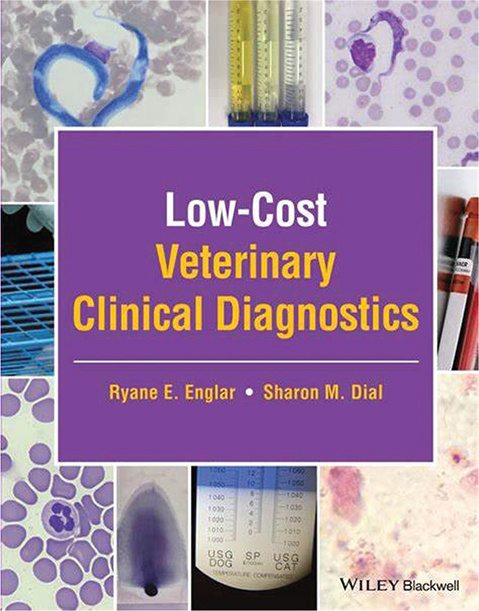BOOK REVIEW
Low-Cost Veterinary Clinical Diagnostics
Ryane E. Englar and Sharon M. Dial
368 pages. 2023. Wiley-Blackwell. ISBN: 978-1-119-71456-9. Price $109.99.
Citation: Journal of Shelter Medicine and Community Animal Health 2023, 2: 67 - http://dx.doi.org/10.56771/jsmcah.v2.67
Copyright: © 2023 Brian A. DiGangi. This is an Open Access article distributed under the terms of the Creative Commons Attribution 4.0 International License (http://creativecommons.org/licenses/by/4.0/), allowing third parties to copy and redistribute the material in any medium or format and to remix, transform, and build upon the material for any purpose, even commercially, provided the original work is properly cited and states its license.
Published: 3 October 2023

Low-cost veterinary clinical diagnostics is a concise, protocol-based textbook highlighting the incredible value of practical, low-cost, point-of-care diagnostic testing methods. The authors’ expertise and passion for combining pedagogy with functional and relatable resources for clinical practice are evident in the structure of the text. The result is a book with easily digestible content applicable to students learning these concepts for the first time as well as experienced technicians and veterinarians interested in optimizing the value of quick assessment tests in clinical practice.
The textbook is divided into six sections. Readers may be tempted to skip over Part 1: Patient Care Considerations to dive into the more application-based sections that follow; however, these readers would miss out on a most eloquent and thoughtful discussion of so-called ‘gold standard’ approaches to clinical care. This well-referenced chapter carefully lays out the origins of the ‘gold standard’ along with its limitations. It concludes with a rational explanation of why the veterinary profession must fully embrace a spectrum of care approach and actively teach it to up-and-coming veterinary professionals. The second chapter dives into common communication strategies with plenty of practical examples and sample verbiage to demonstrate key concepts.
Parts 2 through 5 of the textbook discuss quick assessment tests involving blood, urine, feces, and bodily fluids, covering 17 diagnostic tests. Each chapter begins with a brief definition of the diagnostic test at hand along with a broad overview of the relevant biochemical or physiological principles. An explanation of ‘Why Should I Perform this Test?’ follows, pointing out the most common clinical indications for the methodology and emphasizing discretion in diagnostic test selection. A bulleted list of equipment needed to perform the test along with step-by-step instructions for conducting the test are then presented. Throughout these sections, the seemingly simplest of protocols are accompanied by plenty of pictures to guide even the most inexperienced diagnostician and ensure testing consistency. Each protocol is followed by an estimate of the time needed to perform the test, and a section on Procedural Tips and Troubleshooting offers practical solutions to common pitfalls. Discussions on Interpreting Test Results will be most valuable for veterinarians in particular – common differential diagnoses for the given test results are listed along with photos to help describe findings of test results that involve more subjective assessments. Each chapter ends with a succinct discussion of Add-On Tests That You May Need to Consider, carefully describing their indications and how they might assist the clinician in arriving at a diagnosis. These sections offer a welcome guide to practitioners embracing an incremental care approach. Each chapter concludes with a bulleted list of Key Takeaways summarizing the most important concepts for successfully conducting each test.
The final section of the book is dedicated to a series of 15 Clinical Cases that demonstrate the utility of the diagnostic tests presented throughout the preceding chapters. The cases are presented in such a way as to be useful for self-assessment as well as in a teaching environment. A standardized case approach directs the reader to carefully consider the information needed to arrive at a diagnosis and understand how to use low-cost diagnostics to do so. Most of the cases provided would require manual estimates of white blood cell lines with differential counts, which may seem onerous. However, techniques for simplifying this task are presented in the corresponding chapters.
Although there is some repetition by design, those who simply want to expand their knowledge or otherwise enjoy reading academic textbooks could read this book cover-to-cover in just a few hours. Clinical Pearls are distinctly presented in several chapters and often present themselves unsuspectingly along with the answers to enlightening and surprisingly clinically relevant questions such as: Why is urine yellow? How will using dipsticks that are out-of-date or exposed to light impact test results? What is the relationship between infection with Trichuris vulpis and Addison’s disease?
More likely, with its clear, simple, and practical presentation style, this book will easily replace the more dense and ‘academic’ textbooks that often sit on the shelves of in-house laboratories. The procedures within could easily be adopted as the standard operating procedures for a shelter or community animal healthcare clinic without the need to distill relevant content from a traditional clinical pathology or parasitology textbook into a process that is feasible outside of an academic diagnostic laboratory. Those in clinical and diagnostic teaching roles will also find this text valuable in their work.
Reviewed by Brian A. DiGangi, DVM, MS, DABVP
(Canine and Feline Practice, Shelter Medicine Practice)
University of Florida,
College of Veterinary Medicine,
Gainesville,
Florida